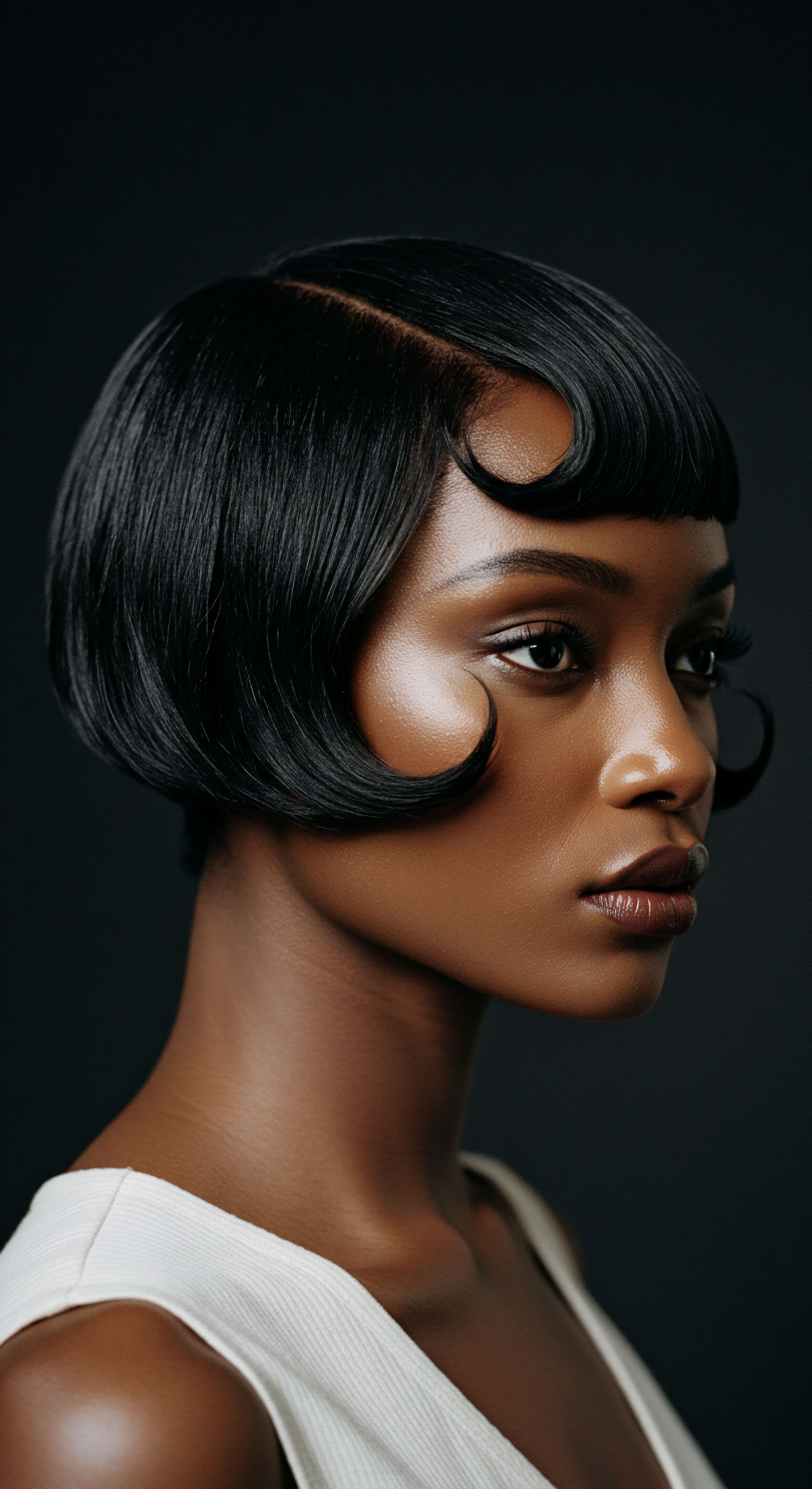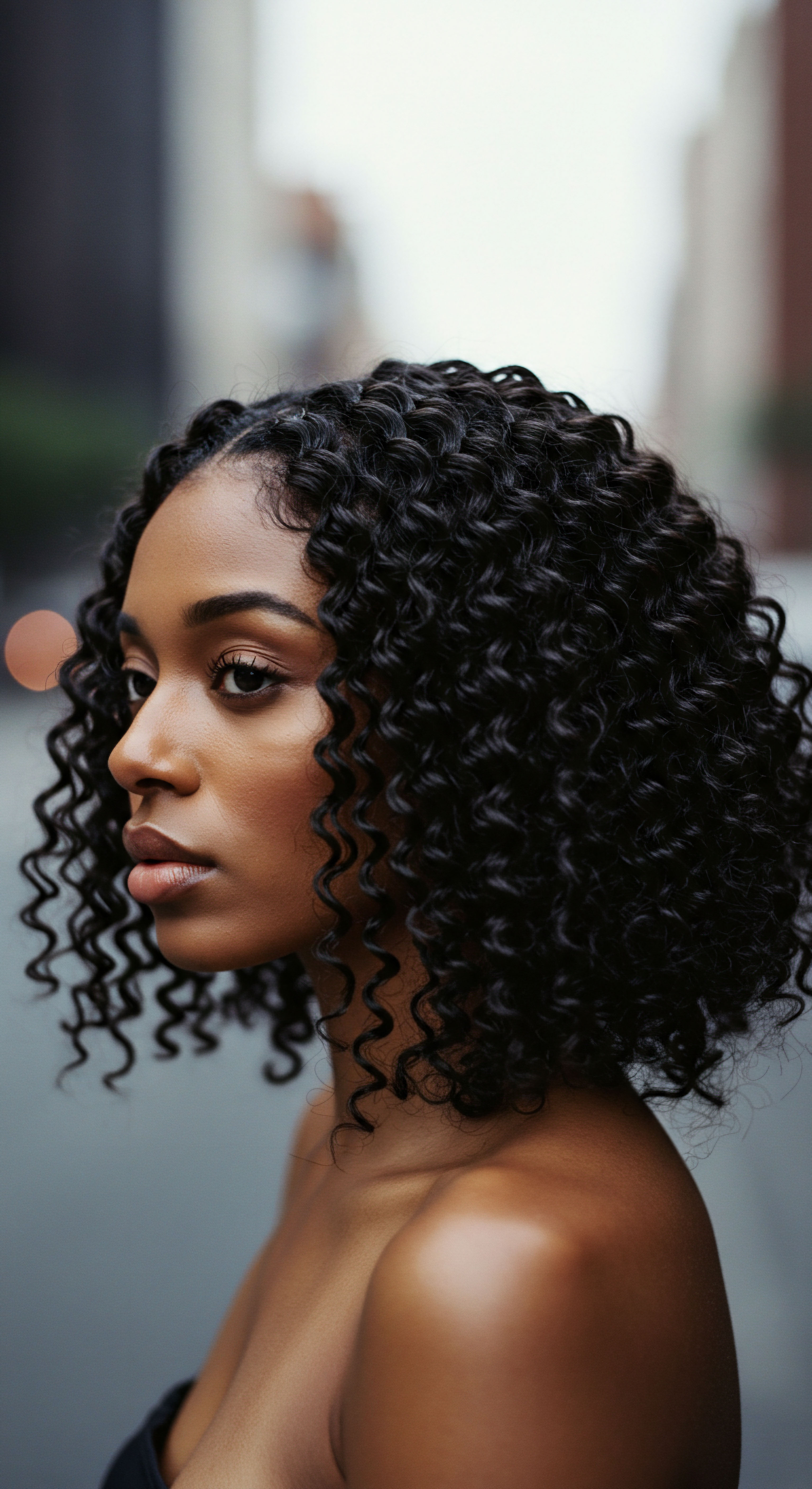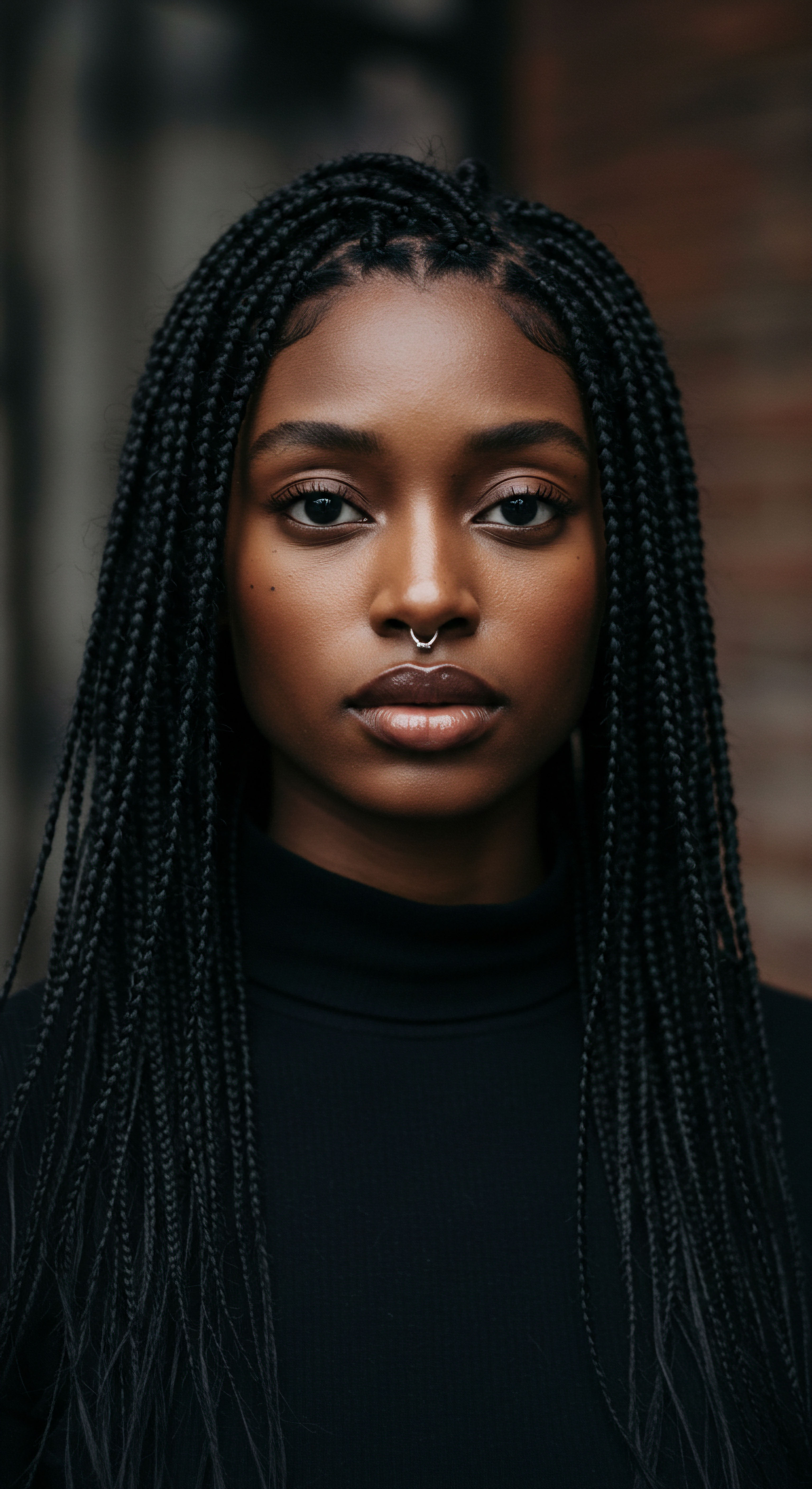
Roots
Consider the quiet wisdom held within generations of hands tending to hair, a wisdom often passed down through touch and observation, long before the advent of chemical compounds or patented formulations. This deep-seated knowledge, born from an intimate relationship with the earth’s bounty and the inherent thirst of strands, forms the very bedrock of our understanding of hair moisture. It is a dialogue between human ingenuity and nature’s generous offerings, a conversation that echoes through time and continues to shape our modern approach to hair care. We begin our exploration not in a laboratory, but in the sun-drenched fields and ancient marketplaces where the earliest remedies for dry, thirsty hair were discovered.

The Primal Thirst of Strands
Every strand of hair, regardless of its texture or origin, possesses an innate desire for hydration. It is a biological imperative, much like the parched earth longing for rain. For textured hair, with its unique structural architecture and often more open cuticle, this yearning for moisture is particularly pronounced. Ancient peoples, observing the ways their hair responded to environmental conditions and natural substances, instinctively understood this fundamental need.
They recognized that dry hair felt brittle, looked dull, and was prone to breakage. Their solutions, therefore, centered on replenishing and sealing in water, often using readily available resources from their immediate surroundings.
From the arid landscapes of North Africa to the lush rainforests of the Amazon, the quest for moisture was a universal pursuit. Water, in its purest form, was the primary hydrator, often softened or infused with botanicals. Yet, water alone, without something to hold it close, quickly evaporated, leaving hair as dry as before. This realization spurred the discovery of natural emollients and humectants.

Whispers of the Earth’s Bounty
The plant kingdom offered an astonishing array of solutions. Across diverse cultures, specific oils and butters became cornerstones of hair moisture regimens. In West Africa, Shea Butter, extracted from the nuts of the shea tree, was revered for its ability to soften and protect. Its rich fatty acid profile provided a substantive barrier, locking in precious moisture and shielding strands from harsh elements.
Similarly, Coconut Oil, a staple in tropical regions like India and Southeast Asia, was prized for its capacity to penetrate the hair shaft, reducing protein loss and lending a remarkable suppleness. Olive oil, a liquid gold of the Mediterranean, was used not only for culinary purposes but also as a profound conditioner, bestowing a visible sheen and elasticity.
Beyond these celebrated oils, a wealth of botanical ingredients contributed to ancient moisture strategies. Mucilaginous plants, such as Flaxseed and Okra, yielded slippery gels when steeped in water. These gels, brimming with polysaccharides, were applied to hair for their conditioning and detangling properties, acting as natural humectants that drew moisture from the air and coated the strands. Herbs like Hibiscus and Amla, prevalent in Ayurvedic traditions, were often steeped to create rinses that not only conditioned but also provided a subtle protective layer, contributing to overall hair health and moisture retention.
Ancient wisdom, rooted in keen observation and an intimate relationship with nature, revealed the fundamental need for hair hydration, leading to the discovery of potent botanical emollients and humectants.

Water’s Timeless Embrace
The simplest, yet perhaps most profound, ancient hair care method for moisture was the direct application of water. However, this was rarely a solitary act. Ancient traditions often involved washing hair with water, sometimes infused with herbs or mild cleansers, followed immediately by the application of oils or butters. This sequential layering ensured that water, the ultimate hydrator, was introduced to the hair shaft, and then sealed in by lipid-rich substances.
This basic principle of Hydrate and Seal, practiced intuitively for millennia, remains a foundational tenet in modern moisture-focused product formulation. The understanding that water is the true moisturizer, and other ingredients serve to assist its retention, was a quiet truth known to our ancestors.

Ritual
As we shift from the foundational understanding of hair’s thirst to the ways in which that thirst was quenched, we find ourselves stepping into the realm of ritual. These were not merely isolated acts of applying a substance, but rather deliberate, often communal, practices that shaped the daily or periodic experience of hair care. The methods, honed over generations, reveal a practical wisdom about sustained hydration and protection. It is here, in the rhythmic application and thoughtful layering of ingredients, that we truly begin to see the echoes of ancient practices within the modern product landscape.

The Daily Dance of Care
Ancient hair care was often characterized by a consistent, almost meditative, engagement with the hair. This was not a quick cleanse and condition, but a multi-step process designed to impart and preserve moisture. For instance, in many African communities, daily oiling or buttering of the hair was a common practice, particularly for children.
This constant replenishment ensured that the hair remained supple and protected from environmental stressors. These daily applications served as precursors to modern leave-in conditioners and styling creams, providing continuous hydration and barrier protection without needing to wash the hair frequently.
The use of plant-based rinses was another widespread ritual. After cleansing, infusions of herbs like Rosemary or Nettle were poured over the hair. While often attributed to scalp health or growth, these rinses also contributed to moisture by providing a light, water-based layer of botanical goodness, preparing the hair for subsequent oil applications.

Layering Wisdom
One of the most striking aspects of ancient moisture rituals was the sophisticated understanding of layering. This was a technique to maximize the absorption and retention of hydrating elements.
- Pre-Poo Treatments ❉ Before cleansing, oils like Castor Oil or Argan Oil were often applied to the hair. This pre-treatment, now recognized as a ‘pre-poo’ in modern parlance, helped to protect the hair from the stripping effects of harsh cleansers, ensuring that essential moisture and lipids were not entirely washed away. It minimized hygral fatigue, the swelling and shrinking of hair cuticles from repeated wetting and drying.
- Post-Wash Sealing ❉ Immediately after washing, while the hair was still damp, richer oils or butters were applied. This technique directly corresponds to the modern concept of ‘sealing’ moisture into the hair. The water, having permeated the hair shaft, was then encapsulated by the lipid layer, significantly reducing its evaporation rate. This simple yet profound practice was key to maintaining soft, pliable hair for days.
- Masks and Deep Treatments ❉ Less frequent, but equally important, were intensive hair masks. Ingredients like mashed avocado, yogurt, honey, or specific plant powders (e.g. henna, although often for color, it also had conditioning properties) were mixed into pastes and left on the hair for extended periods. These provided a concentrated dose of nutrients, lipids, and humectants, akin to today’s deep conditioners and restorative hair treatments.

The Sacred Soak
How did ancient hair care practices shape our understanding of intensive hydration? The ancient practice of ‘co-washing’ or cleansing with conditioning agents, though not termed as such, finds its roots in traditions that prioritized gentle cleansing and moisture retention over harsh stripping. Many cultures used natural substances like Clay (e.g. rhassoul clay from Morocco) or specific plant saponins (e.g.
soap nuts) which cleansed without completely removing the hair’s natural oils. These mild cleansing methods, often followed by conditioning rinses and oil applications, allowed the hair to retain a greater degree of its intrinsic moisture. This careful approach to cleansing, where the goal was not to strip but to refresh and nourish, directly influences the modern emphasis on sulfate-free shampoos, co-washes, and low-lather cleansers designed to preserve hair’s moisture balance. The modern product landscape, with its array of creamy co-washes and conditioning cleansers, truly owes a debt to these ancestral practices that understood the delicate balance required for truly hydrated hair.

Relay
What complex interplay exists between ancient hair moisture practices and the sophisticated formulations of today? Our exploration now ascends to a more intricate plane, where the intuitive wisdom of antiquity converges with the precise insights of modern cosmetic science. It is a dialogue between ancestral observation and molecular understanding, revealing how the very chemistry of nature, once harnessed through trial and error, is now meticulously replicated and enhanced in contemporary product development. The profound depth of this connection reveals itself not merely in shared ingredients, but in the underlying principles of hydration and protection that transcend epochs.

Decoding Ancient Alchemy
The ancient world, without laboratories or microscopes, possessed an astonishing empirical understanding of material properties. They observed how certain oils created a lasting sheen, how specific plant extracts made hair feel softer, and how a combination of water and a lipid could transform brittle strands into pliable ones. Modern cosmetic chemistry has since provided the molecular explanations for these phenomena. For instance, the efficacy of traditional oils like Coconut Oil or Shea Butter for moisture retention is now understood through their fatty acid profiles.
Coconut oil, rich in lauric acid, has a small molecular structure that allows it to penetrate the hair shaft, reducing protein loss and improving elasticity from within. Shea butter, with its high concentration of oleic and stearic acids, forms a protective film on the hair surface, acting as a powerful occlusive agent that minimizes water loss.
This knowledge directly informs the selection of emollients and occlusives in modern formulations. Formulators choose specific silicones, fatty alcohols, and synthetic esters that mimic the desirable properties of these natural lipids, creating products that provide long-lasting moisture and a smooth feel. The objective remains the same ❉ to create a barrier that keeps water within the hair and protects it from external dehydrators.

The Science of Sustained Suppleness
How do plant-derived humectants from antiquity compare to their synthetic counterparts in modern moisture products? The ancient reliance on mucilaginous plants, such as Aloe Vera, Flaxseed, and Okra, offers a compelling parallel to modern humectant technology. These plants produce polysaccharides, complex carbohydrate chains that possess a remarkable capacity to attract and hold water. When applied to hair, these natural polymers create a hygroscopic film, drawing moisture from the environment and binding it to the hair shaft, thus increasing the hair’s water content and flexibility.
A study published in Cosmetics by Cosme, Rodrigues, and Duarte (2021) provides scientific validation for what ancient practices observed. Their review, “Polysaccharides and Glycoproteins as Hair Conditioners,” details how plant-derived polysaccharides, like those from Aloe barbadensis or Linum usitatissimum (flaxseed), function as effective hair conditioners. They highlight the film-forming and humectant properties of these natural biopolymers, explaining how they coat the hair, reduce friction, and bind water, thereby improving hair hydration and manageability.
This research quantifies the hygroscopic nature of these compounds, confirming their ability to act as ancient humectants, which modern cosmetic science now isolates, synthesizes, or utilizes in purified forms (e.g. glycerin, hyaluronic acid, propanediol) to achieve similar moisture-binding effects.
| Ancient Botanical Source Shea Butter (Vitellaria paradoxa) |
| Key Chemical Components Stearic Acid, Oleic Acid |
| Primary Moisture Mechanism Occlusive, Emollient (forms protective barrier, reduces water loss) |
| Modern Cosmetic Analogue Silicones (e.g. Dimethicone), Fatty Alcohols (e.g. Cetyl Alcohol) |
| Ancient Botanical Source Flaxseed (Linum usitatissimum) |
| Key Chemical Components Polysaccharides (Mucilage) |
| Primary Moisture Mechanism Humectant, Film-former (attracts water, coats hair) |
| Modern Cosmetic Analogue Glycerin, Hyaluronic Acid, Polyquaterniums |
| Ancient Botanical Source Coconut Oil (Cocos nucifera) |
| Key Chemical Components Lauric Acid |
| Primary Moisture Mechanism Penetrating Emollient (reduces protein loss, lubricates from within) |
| Modern Cosmetic Analogue Specific Esters, Lipid Replenishers |
| Ancient Botanical Source Aloe Vera (Aloe barbadensis) |
| Key Chemical Components Polysaccharides, Glycoproteins |
| Primary Moisture Mechanism Humectant, Soothing Agent (binds water, calms scalp) |
| Modern Cosmetic Analogue Panthenol, Sodium PCA |
| Ancient Botanical Source This table illustrates how ancient botanical components provided moisture through mechanisms now mimicked or amplified by modern cosmetic ingredients. |

Cultural Reverberations and Respectful Innovation
The influence of ancient hair care extends beyond mere ingredient lists; it shapes the very philosophy of moisture management. The emphasis on gentle cleansing, the practice of layering products, and the importance of regular deep conditioning treatments—all have clear precedents in historical practices. However, this transfer of knowledge requires a thoughtful approach. The commercialization of traditional practices sometimes risks cultural appropriation, stripping practices of their original context and meaning.
Responsible modern formulation, therefore, involves not just extracting compounds, but understanding the holistic context of their historical use. It involves collaboration with communities where these traditions originated, ensuring fair benefit sharing, and acknowledging the deep cultural significance of these practices. When a brand develops a “shea butter deep conditioner,” it is not simply using an ingredient; it is drawing upon centuries of ancestral wisdom. Acknowledging this heritage elevates the product beyond its chemical components, imbuing it with a sense of continuity and respect.
Modern cosmetic science validates ancient hair care principles, demonstrating how plant-derived lipids and polysaccharides functioned as effective emollients and humectants, directly informing today’s sophisticated formulations.
The challenge for contemporary formulators lies in taking these time-honored methods and refining them with scientific precision, without losing the spirit of holistic care that defined their origins. This involves optimizing ingredient concentrations, ensuring stability and safety, and developing delivery systems that enhance efficacy. For example, creating stable emulsions that combine water and oil effectively, or designing conditioners that deposit beneficial ingredients precisely where needed on the hair shaft, are advancements that build upon ancient observations.

Reflection
The journey from ancient hair care wisdom to modern product formulation is not a linear progression but a continuous, swirling conversation. It is a testament to the enduring human quest for beauty and wellbeing, a quiet acknowledgment that the secrets of sustained moisture were whispered by the earth long before they were deciphered in a lab. The soft touch of shea, the slippery comfort of flaxseed, the simple act of dampening and sealing—these were not just practices, but profound insights into hair’s delicate balance. Today, as we navigate a landscape of increasingly complex formulations, the gentle echo of these ancient methods reminds us that at the heart of true moisture lies a timeless understanding of hair’s inherent needs, a grounding presence that guides our steps forward.

References
- Cosme, F. R. Rodrigues, J. R. L. & Duarte, J. A. P. C. (2021). Polysaccharides and Glycoproteins as Hair Conditioners ❉ A Review. Cosmetics, 8(3), 64.
- Gavazzoni Dias, M. F. R. (2015). Hair Cosmetics ❉ An Overview. International Journal of Trichology, 7(1), 2-15.
- Robins, J. (2007). Hair Care ❉ An Illustrated Dermatological Guide. Blackwell Publishing.
- Schueller, R. & Romanowski, P. (2017). Conditioning Agents for Hair and Skin ❉ Structure, Function and Delivery. CRC Press.
- Silva, J. L. C. R. Silva, A. M. O. Lins, R. D. & Lima, J. P. L. (2020). Natural Polymers for Hair Care. In Natural Polymers in Cosmetic Science and Technology (pp. 209-228). Springer.
- Sivamani, R. K. & Jagdeo, J. R. (2017). Hair and Nail Care in Dermatology. CRC Press.
- Zviak, C. (1986). The Science of Hair Care. Marcel Dekker.